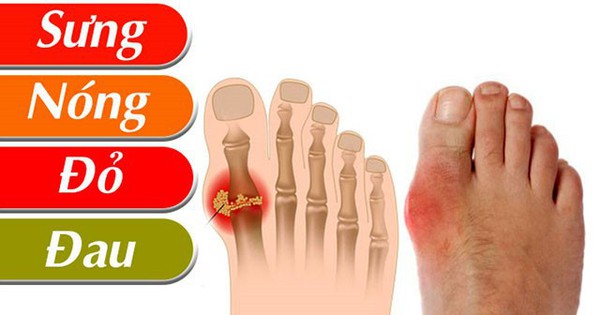The main cause of gout is a disorder of purine metabolism in the body, causing the kidneys to be unable to filter out uric acid, leading to its accumulation in the blood.
The main cause of gout is a disorder of purine metabolism in the body, causing the kidneys to be unable to filter out uric acid, leading to its accumulation in the blood.
Recently, Medlatec Healthcare System received a 17-year-old male student who came to the clinic with a dull pain in the first metatarsal joint of his left foot that had lasted for 2 years.
After being diagnosed with chronic gout, the patient received timely treatment and recovered quickly. His case surprised many people, because gout is often thought to only occur in the elderly, especially those with unhealthy diets or who are overweight.
The patient is LMH, a male student in Hanoi, who has repeatedly experienced joint pain in the toes of his left foot over the past two years. Each episode of pain lasts from 3 to 5 days and subsides on its own without treatment.
However, during the recent pain, the left metatarsal joint was not only severely painful but also swollen, hot, and constantly painful, especially when moving, making her decide to go to the doctor. Although she had no history of trauma or pain in other joints, her family still took her to the hospital when her condition showed no signs of improvement.
 |
| Typical symptoms of gout include sudden, severe joint pain, swelling, warmth around the joint, and pain with movement. |
Previously, the family said that LMH had congenital heart disease, specifically tetralogy of Fallot, and had surgery more than 15 years ago.
Although LMH has been treated for heart disease, he still needs to have regular heart check-ups. An important factor is that his maternal grandfather also has gout in his family, which increases LMH's risk of getting the disease.
After examination, the doctors discovered that the joint of the left toe was swollen, hot but not red. In particular, when pressing on the joint, the child felt a lot of pain and the joint movement was limited.
Additional tests showed that LMH's blood uric acid level was abnormally high (543.22 µmol/L), and a CT scan showed urate crystal deposits in the metatarsophalangeal joint of his left foot. These are typical signs of gout. After a week of treatment, LMH's pain was gone and he made a full recovery.
What is noteworthy in this case is that LMH had gout since he was only 15 years old, but because the symptoms of joint pain were not obvious and went away on their own after a while, he did not realize that he had the disease. It was not until the condition became more serious and painful that his family decided to take him to the hospital.
Gout, also known as gout, is a type of arthritis caused by a buildup of uric acid in the blood. When uric acid levels in the blood are too high, urate crystals form and deposit in the joints, causing inflammation, swelling, and pain.
Although this disease is common in the elderly and those with an unhealthy diet, gout can occur at any age, especially when there are genetic factors or underlying medical conditions.
The main cause of gout is a disorder of purine metabolism in the body, causing the kidneys to be unable to filter out uric acid, leading to its accumulation in the blood. Risk factors include eating a lot of protein and seafood, drinking a lot of beer and alcohol, obesity, and especially having a family history of gout.
The case of the LMH male student shows that gout can occur in young people, especially if there is a genetic factor such as someone in the family having the disease.
LMH, although only 17 years old, has a family history of gout (maternal grandfather), combined with congenital heart disease, putting her at higher risk of gout. This emphasizes the importance of early detection and timely treatment to prevent serious complications.
Typical symptoms of gout include sudden, severe joint pain, swelling, warmth around the joint, and pain with movement.
In particular, patients may feel this pain occurring at night or after eating a lot of protein-rich foods. To make an accurate diagnosis, doctors often request a uric acid blood test, joint imaging, and joint fluid examination.
According to experts, gout can be effectively treated if detected early. Treatment mainly includes painkillers, drugs to reduce uric acid in the blood, and dietary changes.
Patients need to maintain a healthy diet, drink enough water, limit alcohol and protein-rich foods to control uric acid levels in the blood.
In addition, doctors also recommend that patients need regular health check-ups, especially those with genetic factors or underlying diseases such as cardiovascular disease or being overweight.
Gout is hereditary, so people with family members with the disease need to proactively check their health regularly to detect early signs of the disease.
Dr. Trinh Thi Nga, Head of the Department of Musculoskeletal Medicine at Medlatec, recommends that people with a family history of gout should proactively have regular check-ups and tests, especially blood uric acid levels, to detect the disease early and control the condition well.
Gout is not a disease of the rich or only occurs in people with irregular eating habits, but can affect anyone, especially young people and those with genetic factors.
Therefore, proper health care, maintaining a reasonable diet and regular health check-ups are very important to prevent disease progression and protect each person's quality of life.
Source: https://baodautu.vn/nam-sinh-17-tuoi-mac-benh-gut-man-ma-khong-he-hay-biet-d241175.html





![[Photo] Overcoming all difficulties, speeding up construction progress of Hoa Binh Hydropower Plant Expansion Project](https://vstatic.vietnam.vn/vietnam/resource/IMAGE/2025/4/12/bff04b551e98484c84d74c8faa3526e0)

![[Photo] Closing of the 11th Conference of the 13th Central Committee of the Communist Party of Vietnam](https://vstatic.vietnam.vn/vietnam/resource/IMAGE/2025/4/12/114b57fe6e9b4814a5ddfacf6dfe5b7f)











![[Video] First time in Vietnam: Successful implantation of 3rd generation partial artificial heart](https://vstatic.vietnam.vn/vietnam/resource/IMAGE/2025/4/12/8817412224094c68ba2c744b7bd5cfea)













































































Comment (0)